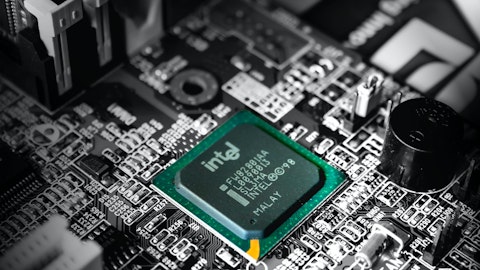Matt Ramsay: Yeah, thank you very much, guys. Good afternoon. Matt, I think you addressed the AI revenue commentary. I wanted to ask about the sort of goalpost for custom silicon. We had been in — we’ve had that conversation around $400 million and then $800 million and then it got pushed out a little bit. And there has been I mean — I don’t think any of us have seen anything like the CapEx shifts that have happened around Generative AI and spending patterns at a lot of your large customers. What we’ve observed is, a lot of custom compute ASIC programs in flight, some of them are for sort of CPU offload and whether it’s called DPU or SmartNIC or whatever you want to call it, some of them are for smaller model inference custom silicon programs at hyperscale.
Maybe you could talk a little bit about where your engagements are? What you’re seeing in terms of timing and magnitude? Because it’s been such a tumultuous CapEx environment with AI versus traditional compute. And if you have any updates on some of those numbers around the custom compute programs and timing, that would be really helpful. Thanks, guys.
Matt Murphy: Yeah, great. Thanks for the question. I’d say a couple of things, Matt. The first is on your question about the custom silicon opportunity, which really if you sort of summarize the different pieces of it as you mentioned, it’s really of all to provide accelerated computing, right, in a custom format for these various companies. I think the overall CapEx shift towards accelerated computing is clearly going to benefit those that are participating in that segment, including us. And we do see — and some of that overlapped, and that’s why last quarter we tried to decouple them somewhat. But some of that revenue obviously overlaps with the AI numbers I gave earlier. But it’s certainly a positive setup. We talked about having two different products last quarter that were kind of the lead ones that were tied to AI.
One of which was in sample stage. That product is looking very good and most likely go into production first pass. The second product taped out as we expected in the second quarter, and that’s also planned to ramp up next year. The size and the timing of those are still to be determined. We’re working with our customers on those. But the overall shift in CapEx spending is clearly a tailwind on that business. So I’d sort of say to calibrate it today kind of tracking towards what we updated you guys on the last time, and then next year, it really depends on how much it moves over, Matt, and how much it can actually — how much business can be driven. So, we’re not calling that, other than to say it’s — the custom stuff for us is mostly going to be driven by AI next year in terms of the…
Matt Ramsay: Got it. No, thank you, Matt. Appreciate it.
Matt Murphy: Yeah.
Operator: The next question is from Harsh Kumar with Piper Sandler. Please go ahead.
Harsh Kumar: Yeah, hey. I think when you talked about gross margin drivers for fourth quarter, Matt, you mentioned that you might be expecting a significant recovery in revenues as well. Did I, a, understand that correctly? And if so, could you talk about what might be happening in the fourth quarter to drive that recovery?
Matt Murphy: Yeah. You’re saying overall, Harsh?
Harsh Kumar: Yes.
Matt Murphy: Your question is, what’s sort of the view? Yeah, obviously, we’re guiding one quarter at a time, but to give you some perspective because we gave you a lots of puts and takes including commentary about carrier and wireless, which we’ve been actually saying for several quarters now relative to that, 5G run taking a pause. Overall, we expect revenues to be up again in the fourth quarter. We were sort of consistent with what we outlined in last quarter’s call, which is that Q3 and Q4 growth would accelerate. So kind of think of that as — growing again in the fourth quarter sort of like we did in Q3. But really driven by cloud and AI, and AI being the big driver. But also as we said in our prepared remarks, standard cloud infrastructure revenues are also growing very nicely through the year, not only from Q2 — Q1 to Q2 and Q2 to Q3, but also into the fourth quarter and beyond.
And that means if you kind of do the back of the envelope, data center becomes a bigger part of our revenue and AI becomes a bigger part of our revenue by the fourth quarter. And then overall Marvell, Inc. is also up. So, I just kind of frame it at a high level, we did set out a long time ago to have a diversified strategy within data infrastructure by serving multiple end markets with a suite of products. So, we’ve got enterprise, 5G, automotive, data center. And as you’ve seen even in this dynamic environment, certain quarters some are performing better than others, and then we’re sort of blessed to have markets that then have kicked in at the right time. So, even in a tough macro right now, Marvell is continuing to grow throughout the year starting from our first quarter, and we anticipate that growth obviously going through Q3 and then through Q4.
But the mix shifting by end market, if that makes sense. I know you will create your model and — we give enough commentary I think to put the pieces together.
Harsh Kumar: No, we appreciate it, Matt. Thank you so much.
Matt Murphy: Yeah.
Operator: The next question is from Christopher Rolland with Susquehanna. Please go ahead.





